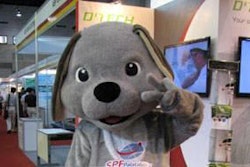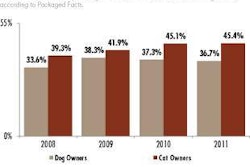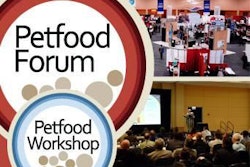Considering that the worldwide economy is still shaky -- with unemployment remaining high and consumer confidence low in many regions, and industries like petfood still coping with issues like volatility in ingredient availability and pricing -- it would not be a surprise for members of our industry to worry about the near future. But I believe most people who attended Petfood Forum Asia 2012 last week in Bangkok, Thailand, walked away with a "glass half full" view of our industry.
From the numbers, countries of origin, company affiliation and engagement of the attendees to the information shared by expert speakers, a distinctively positive picture and optimistic outlook on petfood emerged, especially in the Asia-Pacific market. Likewise, Victam Asia 2012, the agrifeed trade show with which Petfood Forum Asia co-located, enjoyed record numbers of both exhibitors and visitors as well as high engagement. Nearly every exhibitor I spoke with reported an encouraging number of meaningful conversations and strong business leads to follow up on.
More than 135 professionals participated in Petfood Forum Asia on February 16. Countries represented included Japan, Singapore, Korea, China, the Philippines, India, Australia, Brazil, USA, Canada, Germany, Denmark, England and France, as well as the host country, Thailand. Petfood companies represented included Royal Canin, Mars Petcare, Procter & Gamble, Del Monte, Unicharm, Perfect Companion, Nippon Pet Food, Betagro, Total Alimentos and many more.
Attendees listened to David Whye Tye Ng, executive director and CEO of Pet Lovers Centre, describe how his pet retail chain grew sales 25% in Singapore last year (and now owns 46.3% of the pet retail market there) and 35% in Malaysia. The chain's rapid growth, which Ng hopes to continue with expansion into other Asia-Pacific countries, comes from a focus on people, he said. That includes both customers -- which the chain engages with strong service, a loyalty program accessible by smartphone and an in-store customer service rating device -- as well as staff, starting with hiring professionals (such as veterinarians) from other countries when necessary and continuing with at least 72 hours of training per employee each year (with at least 18 hours focused on service.
Following Ng, Warangkana Anuwong of Euromonitor International (and, like Ng, based in Singapore), shared encouraging data, such as:
- Pet ownership is rising in the Asia-Pacific region, with dog ownership especially growing fast, increasing from just over 54% in 2006 to 62% in 2011. (Cat ownership lags at just 17.7%.)
- She projects cat ownership to grow 4% by 2016, dog ownership, 14%, and ownership of other pets, 7%.
- Excluding non-grocery retailers, sales in all channels where pet products are sold in the region have grown significantly from 2006-2011, led by 168% growth in Internet sales, 118% growth in pet superstores and 63% growth in supermarkets/hypermarkets.
- While the growth rate for pet product sales in Asia-Pacific countries has slowed, it still far outpaces annual GDP growth in those countries, proving the strength of the pet market.
- Euromonitor projects cat food sales in the region to increase 7.7% by 2016 and dog food sales to rise 7.4%, with premium products driving the growth.
Other Petfood Forum Asia speakers discussed the growing natural and organic ingredient and supplement market for pets (Greg Tilford of Animals' Apawthecary/Animal Essentials); validating extrusion temperature as a critical control point in the petfood process for killing pathogens (Galen Rokey of Wenger); a systematic approach to dog palatability (Elodie Reveret of SPF); prebiotics, probiotics and synbiotics as functional ingredients for dogs (Dr. K.B. Kore of Navasari University in India); and mycotoxins in the Asian petfood market (Dr. Robert Coppock of Toxicologist and Associates).
Several speakers received questions after their presentations or had attendees seek them out during breaks. This engagement, coupled with the overwhelmingly positive stories shared by speakers and attendees alike, is indeed good news for our industry.
















